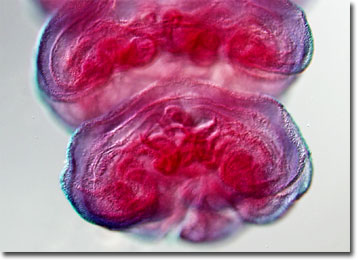Differential Interference Contrast Image Gallery
Aurelia Jellyfish (Strobila Stage)
Aurelia is a genus of jellyfish that belongs to the class Scyphozoa. Members of the genus have a complex lifecycle in which they exist in a variety of distinct forms, although the adult medusa stage is dominant.

Primarily found in coastal waters, the mature marine invertebrates may grow as large as 40 centimeters in diameter. Their medusoid bodies are bell-shaped, but some species lack the long, stinging tentacles frequently associated with jellyfish. In fact, Aurelia aurita, better known as the moon jelly, has tentacles so small that few notice them on first sight. Close inspection reveals, however, numerous short, fine structures lining the bell margins of the organisms. Since their tentacles are not well suited for capturing prey, moon jellies often ensnare zooplankton with the mucus that covers their outer surfaces, transporting the food to their mouths with the help of cilia.
Aurelia jellyfish are unisexual, males releasing spermatozoa into the sea to fertilize the eggs of a female. Embryos are spawned in the mother and develop into gastrulae, or planula larvae. Once released, each larva lives on its own until it finds an appropriate surface to which it attaches, growing into a polyp known as a scyphistoma. The scyphistoma then undergoes an asexual process of fission called strobilation to produce tiny ephyrae, which will mature to become the next generation of medusae. In this stage, the scyphistoma is referred to as a strobila. The ephyrae accumulate in a stack at the oral end of the scyphistoma and are eventually released to become free-swimming individuals that will become sexually mature medusae in less than a year.
